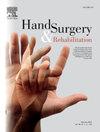两种不同手法治疗拇指发育不全儿童后的功能和美学效果比较研究。
IF 1
4区 医学
Q4 ORTHOPEDICS
引用次数: 0
摘要
背景:由于在进行指数极化时描述了几种皮肤切口模式,目前很难知道一种切口是否优于另一种。假设:分析了两种不同切口模式的极化技术(Buck-Gramcko和Malek技术)的功能和美学结果。患者和方法:在1987年至2021年间接受手术的81例患者中,有48例手术手完成了43份自我问卷,其中24例进行了研究回顾。根据巴克·葛兰科和马雷克的技术分别进行了18次和30次极化。结果:在功能分析评估后,两组在第一连接外观、新拇指主动外展、握力评估、疤痕外观和可见性以及新拇指周长方面均无显著差异。然而,在最后一次随访中,采用Buck-Gramcko技术的组大拇指被动外展更好。无论采用何种技术,患者总体上对新拇指的整体功能、美观和日常使用感到满意,这一点通过自我填写的问卷得到了证实。结论:本研究证实了Buck-Gramcko手法在拇指被动外展方面的优越性。对新拇指的功能或美观没有影响,不同技术的结果具有可比性。主要的预后因素需要额外的手术涉及对侧肌肉转移是与桡骨棒手的关联。证据等级:iii级——回顾性比较研究。本文章由计算机程序翻译,如有差异,请以英文原文为准。
Functional and aesthetic outcomes after index pollicization using two different techniques in children with thumb hypoplasia – A comparative study
Background
As several skin incision patterns have been described when performing index pollicization, it is currently difficult to know whether one incision is superior to another.
Hypothesis
Functional and aesthetic outcomes of two techniques of pollicization that differ in the incision pattern (Buck-Gramcko and Malek’s technique) were analyzed.
Patients and methods
Of 81 patients operated on between 1987 and 2021, 43 self-questionnaires were completed on 48 pollicized hands and 24 were reviewed for the study. Eighteen and 30 pollicizations were performed according to Buck Gramcko’s and Malek’s techniques, respectively.
Results
Following a functional analysis evaluation, no significant differences were observed between the two groups in terms of the appearance of the first commissure, active abduction of the neo-thumb, grip assessment, scar appearance and visibility, and neo-thumb girth. However, passive abduction of the thumb was better in the group operated on using Buck-Gramcko's technique at the last follow-up. Regardless of the technique used, patients were generally satisfied with the overall function, aesthetics, and daily use of the neo-thumb, as demonstrated by self-completed questionnaires.
Conclusion
This investigation demonstrated the superiority of Buck-Gramcko's technique in terms of passive abduction of the thumb. There was no impact on the function or aesthetics of the neo-thumb, and the results were comparable across the different techniques. The main prognostic factor requiring additional procedures involving opposition muscle transfer is the association with a radial club hand.
Level of evidence
Level III—Retrospective comparative study.
求助全文
通过发布文献求助,成功后即可免费获取论文全文。
去求助
来源期刊

Hand Surgery & Rehabilitation
Medicine-Surgery
CiteScore
1.70
自引率
27.30%
发文量
0
审稿时长
49 days
期刊介绍:
As the official publication of the French, Belgian and Swiss Societies for Surgery of the Hand, as well as of the French Society of Rehabilitation of the Hand & Upper Limb, ''Hand Surgery and Rehabilitation'' - formerly named "Chirurgie de la Main" - publishes original articles, literature reviews, technical notes, and clinical cases. It is indexed in the main international databases (including Medline). Initially a platform for French-speaking hand surgeons, the journal will now publish its articles in English to disseminate its author''s scientific findings more widely. The journal also includes a biannual supplement in French, the monograph of the French Society for Surgery of the Hand, where comprehensive reviews in the fields of hand, peripheral nerve and upper limb surgery are presented.
Organe officiel de la Société française de chirurgie de la main, de la Société française de Rééducation de la main (SFRM-GEMMSOR), de la Société suisse de chirurgie de la main et du Belgian Hand Group, indexée dans les grandes bases de données internationales (Medline, Embase, Pascal, Scopus), Hand Surgery and Rehabilitation - anciennement titrée Chirurgie de la main - publie des articles originaux, des revues de la littérature, des notes techniques, des cas clinique. Initialement plateforme d''expression francophone de la spécialité, la revue s''oriente désormais vers l''anglais pour devenir une référence scientifique et de formation de la spécialité en France et en Europe. Avec 6 publications en anglais par an, la revue comprend également un supplément biannuel, la monographie du GEM, où sont présentées en français, des mises au point complètes dans les domaines de la chirurgie de la main, des nerfs périphériques et du membre supérieur.
 求助内容:
求助内容: 应助结果提醒方式:
应助结果提醒方式:


